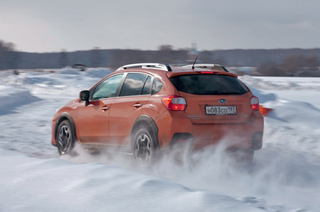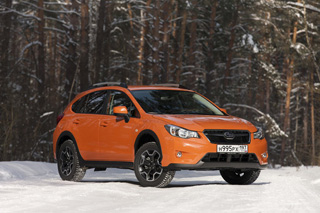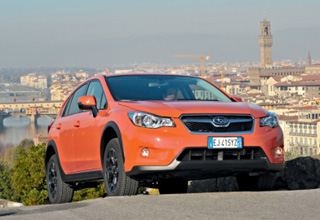Test Drive Subaru XV since 2012 Crossover
Half full
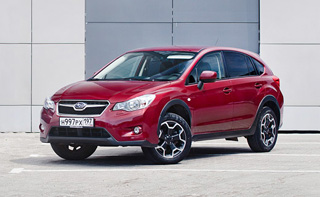 Long-term test Subaru XV: part first.
Long-term test Subaru XV: part first. Four-wheel drive in the summer absurd? Why is it needed on dry asphalt? To find out if there is a sense in a constant full-wheel drive in dry and warm weather, the engine took on the long test of the SUBARU XV hatchback.
The first impression that in front of you is not a car, but a military fortification. Rough body design causes associations rather with a skillful swallow machine-gun nest than with a family crossover. Bottom plastic edging, as if the foundation, then massive influxs around the wheeled arches, and from somewhere from the depths of you are watching two frowning headlights. To see such as if to look into the blowing gun induced on you.
At the catchy appearance of XV react not only pedestrians, but also drivers. At first it seemed strange that when inquiring into the Moscow stream of cars, you were not only missing, but often rushing. Eh, if they knew that there was under the hood
After all, for the test, we chose the most democratic option XV with a gasoline engine 1.6 and a variator. Machine with high ground clearance, automatic and full drive has all the success of success for our market, but is it enough enough?
Sitting into the car, it is difficult to forget about her formidable appearance. Indeed, if it looks like a reinforced defensive point outside, then inside the situation must be appropriate. Why the machine gun chic? The entire central console is sustained in black with silver inserts for metal. Plastic himself, though it looks rude, but on the touch soft.
At first glance, the interior seems pretty dreary and gloomy. Maybe at least electronics at the height? But no: Magnetola with buttons on the steering wheel, three climate control washers, ESP shutdown button. That's all the electronic toys. By the level of equipment, Subaru XV reminds the phone for which you can only call. The only option that somehow sews the soul to computer geac is a USB socket hidden in the central armrest. Nearby made a deepening for the furnishings, but two grenades will look there more logically than dairy cocktails.
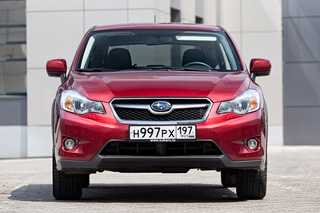 But still, at least the interior and is designed in Spartan style, it is not deprived of Japanese practicality and convenience. The simplicity also has its own charm. For XV with engine 1.6, only ordinary heated seats are offered, but thanks to a set of settings to sit in them convenient. Elastic back and good side support will allow any fatigue to drive and 300, and 500 kilometers.
But still, at least the interior and is designed in Spartan style, it is not deprived of Japanese practicality and convenience. The simplicity also has its own charm. For XV with engine 1.6, only ordinary heated seats are offered, but thanks to a set of settings to sit in them convenient. Elastic back and good side support will allow any fatigue to drive and 300, and 500 kilometers. Ergonomics of the cabin also does not cause complaints. To all the few keys and tweets easily reach. Everything is standard and easy. Even too: the glazing keys are exactly the same as 15 years ago, and the car mode is only for the driver.
However, most of the fans of the SUBARU brand appreciate these cars not for equipping the cabin, but for how they go. For a four-wheel drive, for example. The versions with the mechanics use a classic symmetrical all-wheel drive scheme, with an ussociate and torque distribution between the axes in equal proportions. And on our, with a variator, a multidisk coupling is used, which divides the moment in the ratio of 60:40 in favor of the front wheels. But is it needed a constant four-wheel drive all the time? Especially in the city
In Moscow, at XV, it is very convenient to go with the variator. The gearbox at the time of touching from the spot is not conceived for a second, so the struggle for the place during the rebuilding will be won XV without problems. And it does not matter that the engine of 1.6 liters has only 114 horsepower. To put the nose into the right row in the traffic jam, these forces are enough, and the four-wheel drive will not allow the wheels to slip, even if water or dust will be on the road.
But as soon as the flow accelerates, problems will begin. Passports 13.8 seconds to hundreds of sentence. And the point here is not even in the power of the motor, but in the unpredictable result of the maneuver. That is, it is expected that at high speeds XV will slowly accelerate with a complete drive, and even a variator. But even with urban overtakers, the external factors of lifts and the initial speed of the maneuver should also be taken into account.
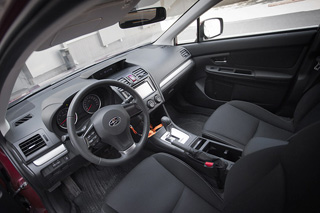 From the moment you have pressed the gas to the floor, and before the start of the accurate acceleration passes, on average, ten seconds. At first, the engine will be promoted to maximum revolutions, then the car will take inertia and only all this will follow a tangible acceleration. If the transfer numbers of the variator are very lucky, then two seconds can go to the speed setting process, but in chaotic moving urban flow all the time you feel uncertainty. It is better not to overtake, and keep in your row.
From the moment you have pressed the gas to the floor, and before the start of the accurate acceleration passes, on average, ten seconds. At first, the engine will be promoted to maximum revolutions, then the car will take inertia and only all this will follow a tangible acceleration. If the transfer numbers of the variator are very lucky, then two seconds can go to the speed setting process, but in chaotic moving urban flow all the time you feel uncertainty. It is better not to overtake, and keep in your row. With rebuildings, only a formidable appearance saves. Take advantage of speed will not work in six cases out of ten.
On the highway, the situation is no better. The engine speakers are enough to overtake one car. But it will have to be ahead of the wagon for a long time, and it is necessary to do it only on a well-looking area you can and do not have time. But at the same time, oddly enough, the rate of a set of speed turns out to be the same by 120 kilometers per hour, which is 160. Such is the feature of the variator. He has no lazy fifth transmission, sharpened for the minimum fuel consumption. If necessary, it will select the necessary gear ratios for 160, and for 180 kilometers per hour.
That's just the consumption of the engine 1.6 it turns out a rather big one. In Moscow traffic jams, the worst indicator of 13.4 liters per hundred. On the track, instant flow rate is noticeably less than about eight liters.
So does the four-wheel drive help in the city and on the lighter in the summer? No! Rather interferes. If it could be turned off, then the acceleration dynamics would certainly have improved. Yes, and the fuel consumption would throw two, or even three liters per hundred kilometers. But Subaru XV options with a mono receive is not only complete.
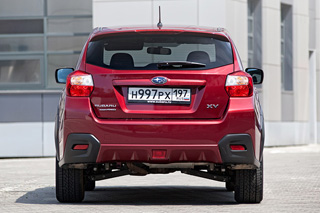 So the only one for the owners of the machine with a full drive to wait for the winter. On the snow-covered, ice or even a mix of their joy will not be borders. It does not matter if they like to go sideways or they will simply move on slippery roads as a hallow. At least the feeling will disappear that they spent extra money on unnecessary skills of their car.
So the only one for the owners of the machine with a full drive to wait for the winter. On the snow-covered, ice or even a mix of their joy will not be borders. It does not matter if they like to go sideways or they will simply move on slippery roads as a hallow. At least the feeling will disappear that they spent extra money on unnecessary skills of their car. However, movement from point A to the point B is not all that should be able to be able to the city crossover. And with everyday tasks XV just copes well. The car without problems storming curbs and other artificial irregularities, which is somewhat expanding parking capabilities. He has a comfortable trunk with hooks under the bags, so the supermarket is also not a problem. Yes, and for passengers, he is not bad. Thanks to a wide sofa and a large footpace, XV can be found to those machines that are convenient to travel a large company. But all this does not make XV some special. With these tasks, almost any crossover will cope.
But what about the branded Subarovski chips like a low center of gravity, the opposite motor and energy-intensive suspension? Do they really do not work? Honestly, it is difficult to imagine the XV owner, which would take advantage of all these benefits on the way to work. To reveal all the talents of Subaru XV, you will have to go away from the city to winding and not very smooth country roads. There, on off-road, we will check whether XV will be able to take revenge for failure in the city.
Exploitation
Common car mileage, kilometers 4675
Mileage from the beginning of the dough, kilometers 570
Fuel consumption, liters per 100 kilometers 13
Specifications Subaru XV 1.6 CVT
Engine type gasoline opposite
Working volume, cube. CM 1600.
Max. Power, hp / rpm 114/5600
Max. Moment, nm / rpm 150/4000
Drive type complete
Transmission CVT.
Front suspension independent McPherson
Rear suspension independent with two A-shaped levers
Brakes Disk Ventilated Front and Disc Rear
Dimensions (DHSHV), mm 4450x1780x1570
Wheel base, mm 2635
Curb weight, kg 1400
Max. Speed, km / h 175
Acceleration 0100 km / h, from 13.1
Fuel consumption (combo), l / 100 km 7.3
CO2 emissions, g / km 171
Fuel tank volume, l 60
Volume of luggage compartment, l 1200
Tire size 225/55R17
Price, rubles from 1 019 000
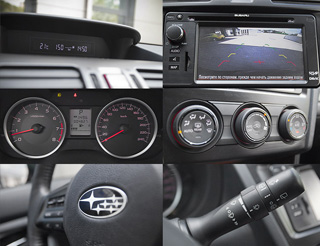
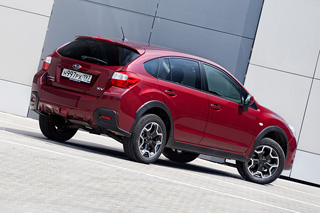
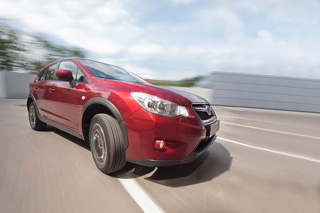
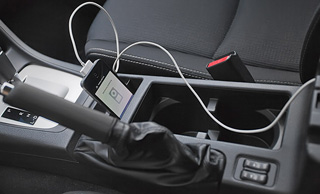
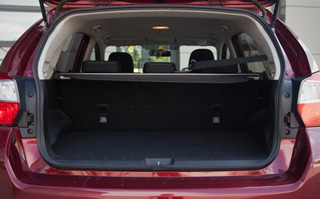
A source: Magazine Motor [July 2012]

.jpg)
.jpg)
.jpg)
.jpg)
.jpg)




